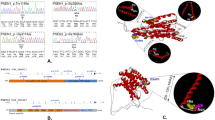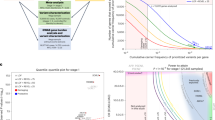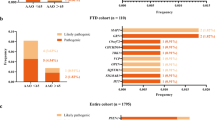Abstract
Over 200 rare and fully penetrant pathogenic mutations in amyloid precursor protein (APP), presenilin 1 and 2 (PSEN1 and PSEN2) cause a subset of early-onset familial Alzheimer’s disease (EO-FAD). Of these, 21 cases of EO-FAD families carrying unique APP locus duplications remain the only pathogenic copy number variations (CNVs) identified to date in Alzheimer’s disease (AD). Using high-density DNA microarrays, we performed a comprehensive genome-wide analysis for the presence of rare CNVs in 261 EO-FAD and early/mixed-onset pedigrees. Our analysis revealed 10 novel private CNVs in 10 EO-FAD families overlapping a set of genes that includes: A2BP1, ABAT, CDH2, CRMP1, DMRT1, EPHA5, EPHA6, ERMP1, EVC, EVC2, FLJ35024 and VLDLR. In addition, CNVs encompassing two known frontotemporal dementia genes, CHMP2B and MAPT were found. To our knowledge, this is the first study reporting rare gene-rich CNVs in EO-FAD and early/mixed-onset AD that are likely to underlie pathogenicity in familial AD and perhaps related dementias.
This is a preview of subscription content, access via your institution
Access options
Subscribe to this journal
Receive 12 print issues and online access
$259.00 per year
only $21.58 per issue
Buy this article
- Purchase on Springer Link
- Instant access to full article PDF
Prices may be subject to local taxes which are calculated during checkout
Similar content being viewed by others
References
Tanzi RE, Bertram L . Twenty years of the Alzheimer's disease amyloid hypothesis: A genetic perspective. Cell 2005; 120: 545–555.
Gatz M, Reynolds CA, Fratiglioni L, Johansson B, Mortimer JA, Berg S et al. Role of genes and environments for explaining Alzheimer disease. Arch Gen Psychiatry 2006; 63: 168–174.
Hooli BV, Tanzi RE . A current view of Alzheimer's disease. F1000 Biol Rep 2009; 1.
Bertram L, Lill CM, Tanzi RE . The genetics of Alzheimer disease: back to the future. Neuron 2010; 68: 270–281.
Bertram L, Tanzi RE . The genetics of Alzheimer's disease. Prog Mol Biol Transl Sci 2012; 107: 79–100.
Feuk L, Carson AR, Scherer SW . Structural variation in the human genome. Nat Rev Genet 2006; 7: 85–97.
Stranger BE, Forrest MS, Dunning M, Ingle CE, Beazley C, Thorne N et al. Relative impact of nucleotide and copy number variation on gene expression phenotypes. Science 2007; 315: 848–853.
Varki A, Geschwind DH, Eichler EE . Explaining human uniqueness: genome interactions with environment, behaviour and culture. Nat Rev Genet 2008; 9: 749–763.
Sebat J, Lakshmi B, Malhotra D, Troge J, Lese-Martin C, Walsh T et al. Strong association of de novo copy number mutations with autism. Science 2007; 316: 445–449.
Levy D, Ronemus M, Yamrom B, Lee YH, Leotta A, Kendall J et al. Rare de novo and transmitted copy-number variation in autistic spectrum disorders. Neuron 2011; 70: 886–897.
Sanders SJ, Ercan-Sencicek AG, Hus V, Luo R, Murtha MT, Moreno-De-Luca D et al. Multiple recurrent de novo CNVs, including duplications of the 7q11.23 Williams syndrome region, are strongly associated with autism. Neuron 2011; 70: 863–885.
Vacic V, McCarthy S, Malhotra D, Murray F, Chou HH, Peoples A et al. Duplications of the neuropeptide receptor gene VIPR2 confer significant risk for schizophrenia. Nature 2011; 471: 499–503.
Bassett AS, Scherer SW, Brzustowicz LM . Copy number variations in schizophrenia: Critical review and new perspectives on concepts of genetics and disease. Am J Psychiatry 2010; 167: 899–914.
Gonzalez E, Kulkarni H, Bolivar H, Mangano A, Sanchez R, Catano G et al. The influence of CCL3L1 gene-containing segmental duplications on HIV-1/AIDS susceptibility. Science 2005; 307: 1434–1440.
Townson JR, Barcellos LF, Nibbs RJ . Gene copy number regulates the production of the human chemokine CCL3-L1. Eur J Immunol 2002; 32: 3016–3026.
Lee C, Scherer SW . The clinical context of copy number variation in the human genome. Expert Rev Mol Med 2010; 12: e8.
Girirajan S, Eichler EE . Phenotypic variability and genetic susceptibility to genomic disorders. Hum Mol Genet 2010; 19: R176–R187.
Ionita-Laza I, Rogers AJ, Lange C, Raby BA, Lee C . Genetic association analysis of copy-number variation (CNV) in human disease pathogenesis. Genomics 2009; 93: 22–26.
Pagnamenta AT, Holt R, Yusuf M, Pinto D, Wing K, Betancur C et al. A family with autism and rare copy number variants disrupting the Duchenne/Becker muscular dystrophy gene DMD and TRPM3. J Neurodev Disord 2011; 3: 124–131.
Chartier-Harlin MC, Kachergus J, Roumier C, Mouroux V, Douay X, Lincoln S et al. Alpha-synuclein locus duplication as a cause of familial Parkinson's disease. Lancet 2004; 364: 1167–1169.
Rovelet-Lecrux A, Hannequin D, Raux G, Le Meur N, Laquerriere A, Vital A et al. APP locus duplication causes autosomal dominant early-onset Alzheimer disease with cerebral amyloid angiopathy. Nat Genet 2006; 38: 24–26.
Bertram L, Schjeide BM, Hooli B, Mullin K, Hiltunen M, Soininen H et al. No association between CALHM1 and Alzheimer's disease risk. Cell 2008; 135: 993–994, author reply 4-6.
Ku CS, Pawitan Y, Sim X, Ong RT, Seielstad M, Lee EJ et al. Genomic copy number variations in three Southeast Asian populations. Hum Mutat 2010; 31: 851–857.
de Andrade M, Atkinson EJ, Bamlet WR, Matsumoto ME, Maharjan S, Slager SL et al. Evaluating the influence of quality control decisions and software algorithms on SNP calling for the affymetrix 6.0 SNP array platform. Hum Hered 2011; 71: 221–233.
Wang K, Li M, Hadley D, Liu R, Glessner J, Grant SF et al. PennCNV: An integrated hidden Markov model designed for high-resolution copy number variation detection in whole-genome SNP genotyping data. Genome Res 2007; 17: 1665–1674.
Database of Genomic Variants [database on the Internet] 2011 Available from http://projects.tcag.ca/variation/project.html.
Iafrate AJ, Feuk L, Rivera MN, Listewnik ML, Donahoe PK, Qi Y et al. Detection of large-scale variation in the human genome. Nat Genet 2004; 36: 949–951.
Zhang J, Feuk L, Duggan GE, Khaja R, Scherer SW . Development of bioinformatics resources for display and analysis of copy number and other structural variants in the human genome. Cytogenet Genome Res 2006; 115: 205–214.
Maiti S, Kumar KH, Castellani CA, O'Reilly R, Singh SM . Ontogenetic de novo copy number variations (CNVs) as a source of genetic individuality: Studies on two families with MZD twins for schizophrenia. PLoS One 2011; 6: e17125.
UCSC Genome Bioinformatics: FAQ [database on the Internet] 2012 Available from http://genome.ucsc.edu/FAQ/FAQformat.html#format1.
Qin J, Jones RC, Ramakrishnan R . Studying copy number variations using a nanofluidic platform. Nucleic Acids Res 2008; 36: e116.
Mohapatra G, Moore DH, Kim DH, Grewal L, Hyun WC, Waldman FM et al. Analyses of brain tumor cell lines confirm a simple model of relationships among fluorescence in situ hybridization, DNA index, and comparative genomic hybridization. Genes Chromosomes Cancer 1997; 20: 311–319.
Pang AW, MacDonald JR, Pinto D, Wei J, Rafiq MA, Conrad DF et al. Towards a comprehensive structural variation map of an individual human genome. Genome Biol 2010; 11: R52.
Hooli BV, Mohapatra G, Mattheisen M, Parrado AR, Roehr JT, Shen Y et al. Role of common and rare APP DNA sequence variants in Alzheimer disease. Neurology 2012; 78: 1250–1257.
Alzheimer Disease & Frontotemporal Dementia Mutation Database [database on the Internet] 1998 cited 21 March 2011.
Kauwe JS, Jacquart S, Chakraverty S, Wang J, Mayo K, Fagan AM et al. Extreme cerebrospinal fluid amyloid beta levels identify family with late-onset Alzheimer's disease presenilin 1 mutation. Ann Neurol 2007; 61: 446–453.
Akiyama M, Ishida N, Ogawa T, Yogo K, Takeya T . Molecular cloning and functional analysis of a novel Cx43 partner protein CIP150. Biochem Biophys Res Commun 2005; 335: 1264–1271.
Farahani R, Pina-Benabou MH, Kyrozis A, Siddiq A, Barradas PC, Chiu FC et al. Alterations in metabolism and gap junction expression may determine the role of astrocytes as "good samaritans" or executioners. Glia 2005; 50: 351–361.
Perez Velazquez JL, Frantseva MV, Naus CC . Gap junctions and neuronal injury: Protectants or executioners? Neuroscientist 2003; 9: 5–9.
Martin B, Brenneman R, Becker KG, Gucek M, Cole RN, Maudsley S . iTRAQ analysis of complex proteome alterations in 3xTgAD Alzheimer's mice: understanding the interface between physiology and disease. PLoS One 2008; 3: e2750.
Bergren SK, Rutter ED, Kearney JA . Fine mapping of an epilepsy modifier gene on mouse Chromosome 19. Mamm Genome 2009; 20: 359–366.
Sund KL, Roelker S, Ramachandran V, Durbin L, Benson DW . Analysis of Ellis van Creveld syndrome gene products: implications for cardiovascular development and disease. Hum Mol Genet 2009; 18: 1813–1824.
Schmidt EF, Strittmatter SM . The CRMP family of proteins and their role in Sema3A signaling. Adv Exp Med Biol 2007; 600: 1–11.
Good PF, Alapat D, Hsu A, Chu C, Perl D, Wen X et al. A role for semaphorin 3A signaling in the degeneration of hippocampal neurons during Alzheimer's disease. J Neurochem 2004; 91: 716–736.
Yamashita N, Uchida Y, Ohshima T, Hirai S, Nakamura F, Taniguchi M et al. Collapsin response mediator protein 1 mediates reelin signaling in cortical neuronal migration. J Neurosci 2006; 26: 13357–13362.
Mukherjee J, DeSouza LV, Micallef J, Karim Z, Croul S, Siu KW et al. Loss of collapsin response mediator Protein1, as detected by iTRAQ analysis, promotes invasion of human gliomas expressing mutant EGFRvIII. Cancer Res 2009; 69: 8545–8554.
Kurnellas MP, Li H, Jain MR, Giraud SN, Nicot AB, Ratnayake A et al. Reduced expression of plasma membrane calcium ATPase 2 and collapsin response mediator protein 1 promotes death of spinal cord neurons. Cell Death Differ 2010; 17: 1501–1510.
Cole AR, Noble W, van Aalten L, Plattner F, Meimaridou R, Hogan D et al. Collapsin response mediator protein-2 hyperphosphorylation is an early event in Alzheimer's disease progression. J Neurochem 2007; 103: 1132–1144.
Weterman MA, van Ruissen F, de Wissel M, Bordewijk L, Samijn JP, van der Pol WL et al. Copy number variation upstream of PMP22 in Charcot-Marie-Tooth disease. Eur J Hum Genet 2010; 18: 421–428.
Hammock EA, Levitt P . Developmental expression mapping of a gene implicated in multiple neurodevelopmental disorders, a2bp1 (fox1). Dev Neurosci 2011; 33: 64–74.
Bhalla K, Phillips HA, Crawford J, McKenzie OL, Mulley JC, Eyre H et al. The de novo chromosome 16 translocations of two patients with abnormal phenotypes (mental retardation and epilepsy) disrupt the A2BP1 gene. J Hum Genet 2004; 49: 308–311.
Martin CL, Duvall JA, Ilkin Y, Simon JS, Arreaza MG, Wilkes K et al. Cytogenetic and molecular characterization of A2BP1/FOX1 as a candidate gene for autism. Am J Med Genet B Neuropsychiatr Genet 2007; 144B: 869–876.
Barnby G, Abbott A, Sykes N, Morris A, Weeks DE, Mott R et al. Candidate-gene screening and association analysis at the autism-susceptibility locus on chromosome 16p: evidence of association at GRIN2A and ABAT. Am J Hum Genet 2005; 76: 950–966.
Wegerer M, Adena S, Pfennig A, Czamara D, Sailer U, Bettecken T et al. Variants within the GABA transaminase (ABAT) gene region are associated with somatosensory evoked EEG potentials in families at high risk for affective disorders. Psychol Med 2013; 43: 1207–1217.
Aiga M, Levinson JN, Bamji SX . N-cadherin and neuroligins cooperate to regulate synapse formation in hippocampal cultures. J Biol Chem 2011; 286: 851–858.
Lefort CT, Wojciechowski K, Hocking DC . N-cadherin cell-cell adhesion complexes are regulated by fibronectin matrix assembly. J Biol Chem 2011; 286: 3149–3160.
Malinverno M, Carta M, Epis R, Marcello E, Verpelli C, Cattabeni F et al. Synaptic localization and activity of ADAM10 regulate excitatory synapses through N-cadherin cleavage. J Neurosci 2010; 30: 16343–16355.
Rieger S, Senghaas N, Walch A, Koster RW . Cadherin-2 controls directional chain migration of cerebellar granule neurons. PLoS Biol 2009; 7: e1000240.
Tan ZJ, Peng Y, Song HL, Zheng JJ, Yu X . N-cadherin-dependent neuron-neuron interaction is required for the maintenance of activity-induced dendrite growth. Proc Natl Acad Sci USA 2010; 107: 9873–9878.
Andreyeva A, Nieweg K, Horstmann K, Klapper S, Muller-Schiffmann A, Korth C et al. C-terminal fragment of N-cadherin accelerates synapse destabilization by amyloid-beta. Brain 2012; 135 (Pt 7): 2140–2154.
Ando K, Uemura K, Kuzuya A, Maesako M, Asada-Utsugi M, Kubota M et al. N-cadherin regulates p38 MAPK signaling via association with JNK-associated leucine zipper protein: implications for neurodegeneration in Alzheimer disease. J Biol Chem 2011; 286: 7619–7628.
Orioli D, Klein R . The Eph receptor family: axonal guidance by contact repulsion. Trends Genet 1997; 13: 354–359.
Savelieva KV, Rajan I, Baker KB, Vogel P, Jarman W, Allen M et al. Learning and memory impairment in Eph receptor A6 knockout mice. Neurosci Lett 2008; 438: 205–209.
Hayashi S, Imoto I, Aizu Y, Okamoto N, Mizuno S, Kurosawa K et al. Clinical application of array-based comparative genomic hybridization by two-stage screening for 536 patients with mental retardation and multiple congenital anomalies. J Hum Genet 2011; 56: 110–124.
Willour VL, Yao Shugart Y, Samuels J, Grados M, Cullen B, Bienvenu OJ 3rd et al. Replication study supports evidence for linkage to 9p24 in obsessive-compulsive disorder. Am J Hum Genet 2004; 75: 508–513.
Funk KE, Mrak RE, Kuret J . Granulovacuolar degeneration (GVD) bodies of Alzheimer's disease (AD) resemble late-stage autophagic organelles. Neuropathol Appl Neurobiol 2011; 37: 295–306.
Yamazaki Y, Takahashi T, Hiji M, Kurashige T, Izumi Y, Yamawaki T et al. Immunopositivity for ESCRT-III subunit CHMP2B in granulovacuolar degeneration of neurons in the Alzheimer's disease hippocampus. Neurosci Lett 2010; 477: 86–90.
Sun Y, Zhang F, Gao J, Gao X, Guo T, Zhang K et al. Positive association between POU1F1 and mental retardation in young females in the Chinese Han population. Hum Mol Genet 2006; 15: 1237–1243.
Turton JP, Reynaud R, Mehta A, Torpiano J, Saveanu A, Woods KS et al. Novel mutations within the POU1F1 gene associated with variable combined pituitary hormone deficiency. J Clin Endocrinol Metab 2005; 90: 4762–4770.
Urwin H, Authier A, Nielsen JE, Metcalf D, Powell C, Froud K et al. Disruption of endocytic trafficking in frontotemporal dementia with CHMP2B mutations. Hum Mol Genet 2010; 19: 2228–2238.
Bertram L, McQueen MB, Mullin K, Blacker D, Tanzi RE . Systematic meta-analyses of Alzheimer disease genetic association studies: the AlzGene database. Nat Genet 2007; 39: 17–23.
Carter CJ . Convergence of genes implicated in Alzheimer's disease on the cerebral cholesterol shuttle: APP, cholesterol, lipoproteins, and atherosclerosis. Neurochem Int 2007; 50: 12–38.
Forster E, Bock HH, Herz J, Chai X, Frotscher M, Zhao S . Emerging topics in Reelin function. Eur J Neurosci 2010; 31: 1511–1518.
Rovelet-Lecrux A, Campion D . Copy number variations involving the microtubule-associated protein tau in human diseases. Biochem Soc Trans 2012; 40: 672–676.
Rovelet-Lecrux A, Hannequin D, Guillin O, Legallic S, Jurici S, Wallon D et al. Frontotemporal dementia phenotype associated with MAPT gene duplication. J Alzheimers Dis 2010; 21: 897–902.
Acknowledgements
This study was funded by grants from the NIMH and the Cure Alzheimer’s Fund.
Author information
Authors and Affiliations
Corresponding author
Ethics declarations
Competing interests
The authors declare no conflict of interest.
Additional information
Supplementary Information accompanies the paper on the Molecular Psychiatry website
Rights and permissions
About this article
Cite this article
Hooli, B., Kovacs-Vajna, Z., Mullin, K. et al. Rare autosomal copy number variations in early-onset familial Alzheimer’s disease. Mol Psychiatry 19, 676–681 (2014). https://doi.org/10.1038/mp.2013.77
Received:
Revised:
Accepted:
Published:
Issue Date:
DOI: https://doi.org/10.1038/mp.2013.77
Keywords
This article is cited by
-
The enhanced association between mutant CHMP2B and spastin is a novel pathological link between frontotemporal dementia and hereditary spastic paraplegias
Acta Neuropathologica Communications (2022)
-
Dissecting the clinical heterogeneity of early-onset Alzheimer’s disease
Molecular Psychiatry (2022)
-
A comprehensive analysis of copy number variation in a Turkish dementia cohort
Human Genomics (2021)
-
The role of genetics in neurodegenerative dementia: a large cohort study in South China
npj Genomic Medicine (2021)
-
Exploring the Genetic Association of the ABAT Gene with Alzheimer’s Disease
Molecular Neurobiology (2021)



